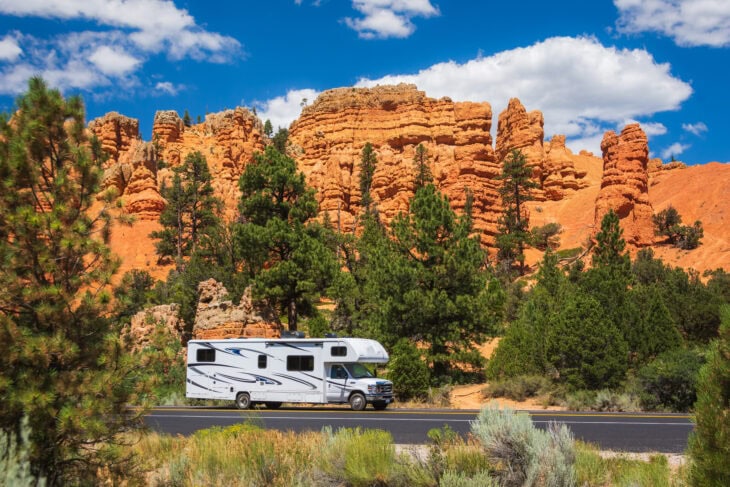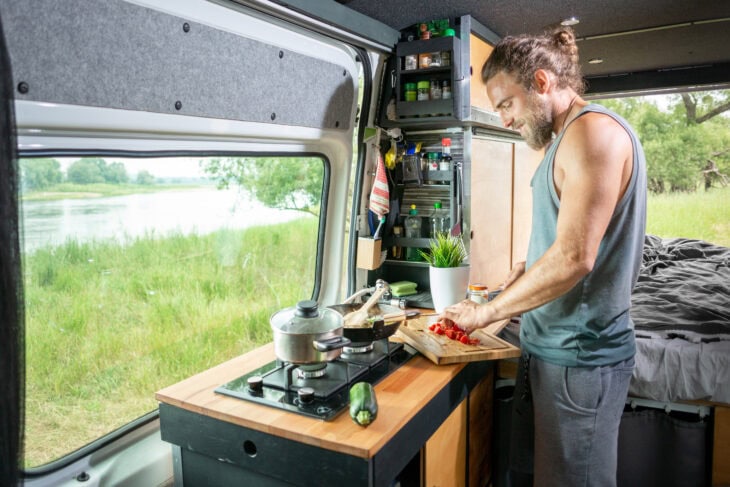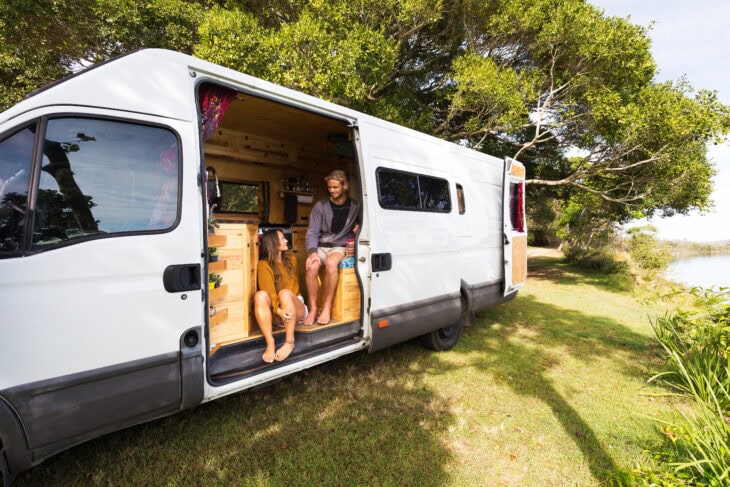
RV and Van Living: How Much Does It Cost?
Thinking about life on the open road? Whether it’s the lure of endless adventure, the need to escape rising housing costs, or the appeal of a minimalistic lifestyle, recreational vehicle (RV) and van life might just be calling your name. Before you dive in, however, it’s important to know the real costs involved. From the initial vehicle purchase to daily living expenses, we’re breaking down everything you need to budget for this nomadic lifestyle.
We’ll also go into some detail that reveals why New Mexico has become well-suited to RV and van life by offering a unique savings opportunity at camping locations throughout the Land of Enchantment, along with some impressive free resources for both new and experienced van lifers.

What Is “Van Living”?
Van living, often referred to as “Van Life,” is a lifestyle where individuals or families live full-time in a converted van or RV. This trend has gained momentum since the beginning of the pandemic through social media and YouTube, where influencers share their experiences.
Key benefits of the lifestyle include:
- Travel Flexibility: Ability to move to new locations at will.
- Reduced Living Costs: Significantly lower than traditional housing.
- Adventure and Minimalism: A simpler, more adventurous way of life.
Initial Costs of Moving to RV & Van Living
When considering a move to RV or van living, the initial costs can be significant. These costs include purchasing the vehicle, converting it for livability, and obtaining necessary insurance and registration.
Vehicle Purchase
- RVs:
- Class A: Luxury motorhomes, $50,000 to $200,000+.
- Class B: Van-like RVs, $60,000 to $200,000+.
- Class C: Mid-sized RVs, $40,000 to $100,000.
- Travel Trailers and Fifth Wheels: $15,000 to $100,000.
- Vans:
- Mercedes Sprinter: Around $70,000 new.
- Ford Transit: Approximately $50,000.
- Ram ProMaster: About $45,000.
New vs. Used Vehicles: New vehicles offer warranties and latest features, but used ones can be more affordable and pre-outfitted.
Find the right type of RV for your needs and learn everything you need to know about RV financing with our free Guide to Adventure Loans: Financing Tips & Strategies For RVs, ATVs, and Campers.

Conversion Costs
Transforming a van into a livable space involves several costs, especially if you want it to be comfortable for long-term living. These costs can vary widely depending on whether you do it yourself or hire professionals.
- DIY Conversions: $10,000 to $20,000 for basic setups.
- Professional Conversions: $60,000 to $90,000, potentially upwards of $125,000 for luxury setups.
- Additional expenses: Insulation, electrical systems, plumbing, furniture.
Examples: Electrical systems ($1,500 to $5,000), plumbing ($500 to $2,000), furniture and interior ($2,000 to $5,000).
Rising prices for goods and services is a real concern for many Americans nowadays – check out our 5 Tips to Protect Your Savings from Inflation.
Registration and Insurance
Insurance and registration are recurring costs that you’ll need to factor into your budget. These costs can vary based on several factors.
- Insurance Costs: $1,500 to $2,000 annually, depending on factors like vehicle type, driving history, and location.
- Registration Fees: Vary by state, typically $50 to $200.

Recurring Costs of RV & Van Living
Recurring costs are a major part of budgeting for RV or van living. These costs include fuel, maintenance, camping fees, utilities, and insurance.
Fuel/Gas
- Fuel costs are a significant recurring expense in RV and van living. They depend heavily on the size of your vehicle and your travel habits.
- Monthly Fuel Costs: Typically will range from $200 to $600, depending on travel frequency and vehicle size.
Example: A van traveling 1,000 miles per month with fuel efficiency of 15 MPG, and gas priced at $3.50 per gallon, would cost approximately $233 monthly.
It’s a good idea to keep an eye on your finances while on the road – check out DNCU’s mobile and online banking services and discover how easy it is to save and manage your money with savings and checking accounts from dncuEVERYDAY.
Maintenance and Repairs
Maintaining your vehicle is crucial to avoid unexpected breakdowns. Regular maintenance and repairs are inevitable and should be budgeted for.
- Regular Maintenance:
- Oil changes ($50 to $100).
- New tires ($500 to $1,000 for a full set).
- Annual inspections ($100 to $200).
- Common Repairs:
- Engine repairs ($500 to $5,000).
- Electrical system repairs ($200 to $2,000).

Camping and Parking Fees
Finding a place to park your RV or van can be a daily cost, especially if you prefer amenities provided by campgrounds or RV parks.
- Paid Campsites: $15 to $30 per night. Monthly costs can range from $500 to $900 if staying every night.
- Boondocking (Free Camping): No cost but may require permits in some areas.
- Membership Programs:
- Passport America: $44 per year.
- KOA: $33 per year.
- Harvest Hosts: $99 per year.
- New Mexico Annual Camping Pass: Unlike many states, New Mexico includes dry camping in a low priced annual pass to enter state parks ($180 for NM residents, $225 non-NM residents). An additional charge applies for electric hook-ups and a third-party fee is levied if you wish to reserve a spot in advance.
New Mexico is currently considering significant changes to its annual pass programs and visitors should check for the latest information at the Energy, Minerals and Natural Resources Department website.
When you bank with dncuEVERYDAY, assistance is always close – check out our network of branches in northern New Mexico and Rio Rancho, and our extensive nationwide ATM network.
Self-Generated Utilities and Services
Living on the road requires managing your own utilities, such as propane for cooking and heating, and water and sewage disposal.
- Propane: $20 to $50 per month.
- Water and Sewage: $10 to $30 per month.
- Wi-Fi and Cellular Data Plans: $30 to $90 per month. Hotspots can cost $50 to $140 per month.
Traveling with your significant other? Find the best ways to make finances a team effort with Tips for Managing Finances With Your Partner or Spouse.
Health Insurance and Mail Services
Healthcare and mail services are essential considerations for those living on the road. Health insurance varies widely based on individual needs, while mail forwarding/digital mail services help you stay connected.
- Healthcare: Plan costs vary widely based on individual needs.
- Mail Forwarding/Digital Mail Services: Typically $10 to $30 per month.
Looking to cut down on spending and save for your upcoming adventure? Check out our Top 10 Tips to Reduce Monthly Spending.

Additional Expenses to Budget for When Living in an RV or Van
Beyond the basic recurring costs, there are additional expenses to consider. These include food, entertainment, and emergencies.
Food and Groceries
Cooking your meals in an RV or van is often more cost-effective than dining out. However, grocery costs can add up.
- Monthly Grocery Costs: For couples, typically range from $700 to $1,000.
Buying Strategies:
- Bulk non-perishables like beans, grains, and rice.
- Avoid over-buying perishables. Purchase as needed.
- Plan meals to save space and reduce food waste.
Entertainment and Activities
Budgeting for entertainment and activities is essential to enjoy your lifestyle on the road.
- Budget for Hobbies and Leisure: $200 to $300 per month.
- National Park Fees and Attractions: Budget for entry fees and recreational activities.
Looking for budget-friendly activities while on the road? Check out our free guide to Low Cost Activities and Trips To Do In New Mexico for some great ideas.
Emergencies and Miscellaneous
Setting aside funds for emergencies is crucial. This includes unexpected health costs, vehicle repairs, and other unforeseen expenses.
- Emergency Funds: Essential for unexpected expenses like health costs and vehicle repairs.
- Pet Expenses: Vet visits, food, vitamins, toys, and pet insurance.
Big expenses can trigger anxiety – check out 12 Ways to Reduce Spending and Financial Stress in our Financial Fitness section.

Ways to Save Money When Living in an RV or Van
There are several strategies to save money while living in an RV or van. These include planning your travel to reduce fuel costs, utilizing free resources, and learning to do your own maintenance.
Budget-Friendly Travel Plans
- Slowing Down: Reduces fuel costs and increases miles per gallon.
- Cost-Effective Routes: Plan routes that minimize expenses and avoid costly routing mistakes.
Utilizing Free Resources
Take advantage of free resources to find camping spots and gather community advice:
- Apps and Websites: Use tools like iOverlander, Net, and GAIA GPS to find free camping spots.
- Community Resources: Engage with the van life community on Reddit, Lemmy, Pinterest, and other sites for ideas and answers.
- Free Media: YouTube channels, including CheapRVLiving, Amanda Outside, and Fate Unbound provide insightful tips and advice on van life and related issues.
Maintenance and DIY Skills
Learning basic vehicle maintenance and undertaking DIY projects can save a substantial amount of money. Some common examples include:
- Oil Changes: Learn to change your own oil and oil filter. This can save you $30 to $50 per occurrence.
- Tire Rotation: Rotating your tires regularly can extend their life.
- Brake Pad Replacement: Replacing brake pads yourself can save $100 to $200 compared to a mechanic’s service.
- Battery Maintenance: Keeping your battery terminals clean and learning to replace a battery can prevent costly breakdowns.
- Installing Solar Panels: Adding solar panels to your van or RV can provide a reliable power source for off-grid living.
- Building Custom Storage: Create built-in storage solutions tailored to your needs using basic carpentry skills.
- Creating a DIY Composting Toilet: Building a composting toilet can be a cost-effective and eco-friendly solution for waste management.
Start your adventure of RV & van living with an RV or Vehicle Loan from DNCU!
So, you’re thinking about hitting the road and embracing the RV or van life? It’s an adventure filled with freedom, scenic routes, and the joy of minimalist living. Just remember, understanding the costs involved — from your initial investment to everyday expenses — is key to making it all work.
Del Norte Credit Union is your home for RV, motorcycle, car, and powersports loans. Reach out to dncuBORROW today at (877)818-DNCU (3628), apply for your loan online, or join our credit union today!
Disclosure: The information provided in this blog about the predicted cost of living for RV and van living is based on current estimates and market conditions. Individual experiences may differ, and costs can vary due to factors such as location, lifestyle choices and economic changes. This blog contains non-affiliate links. Please conduct your own research and consult with financial professionals if needed before making any financial decisions.

